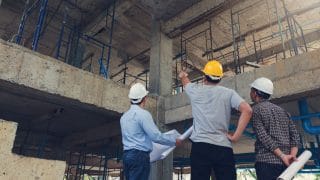What Is the Design-Bid-Build Method in Construction?
Nov 09, 2021

Construction projects require multiple stakeholders working together to achieve the final project. Architects, engineers, and builders must work in tandem to provide the project owner with the right deliverables while staying on time and on budget. One common project delivery method is the design-bid-build approach, which offers a direct path to get from a design on paper to a finished building. For owners without a lot of building experience, the design-bid-build method can be the easiest, most straightforward option available for overseeing the project.
What is the design-bid-build project delivery method?
The design-bid-build method is a linear approach to the design and construction of a building project. A design team works with the project owner to prepare the programming, design the project, and draft the contract documents. Once the design is complete, general contractors bid on the job based on their labor and construction costs, which opens the project up to market competition (and which theoretically lowers construction costs).
There are three parties in a design-bid-build project: the owner, the consultant, and the contractor or builder. The owner requesting the project—whether it’s a hotel, school, or something else entirely—has a set budget and the responsibility to make sure the project goals are met without overspending.
The owner has a direct contract with the consultant, who is usually an architect or engineer. This person acts as the owner’s representative throughout the construction project, although they have no contract with the builder. Instead, they create a separate, second-stage contract between the owner and the builder, which could either be a construction management firm or a general contractor. All three parties need to work together for the project to be successful, particularly in terms of quality assurance and payment applications.
The 3 stages of the design-bid-build process
There are three distinct stages of the design-bid-build process. There’s no overlap to these stages—the next stage can only begin once the previous stage is complete.
1. Design stage
The first step in the design-bid-build method is for the owner to contract with a design consultant, who is usually an architect or an engineer. The consultant creates the complete design documents that meet the owner’s needs for the project, including aesthetic and design considerations, square footage specifications, and overall building cost. The design documents typically include a site plan, plus schematics for electrical, plumbing, mechanical elements of the building, though this depends on the type of building and project. There may be back and forth between the owner and the consultant before they finalize the design draft for the bid stage.
Construction projects require multiple stakeholders working together to achieve the final project. Architects, engineers, and builders must work in tandem to provide the project owner with the right deliverables while staying on time and on budget. One common project delivery method is the design-bid-build approach, which offers a direct path to get from a design on paper to a finished building. For owners without a lot of building experience, the design-bid-build method can be the easiest, most straightforward option available for overseeing the project.
What is the design-bid-build project delivery method?
The design-bid-build method is a linear approach to the design and construction of a building project. A design team works with the project owner to prepare the programming, design the project, and draft the contract documents. Once the design is complete, general contractors bid on the job based on their labor and construction costs, which opens the project up to market competition (and which theoretically lowers construction costs).
There are three parties in a design-bid-build project: the owner, the consultant, and the contractor or builder. The owner requesting the project—whether it’s a hotel, school, or something else entirely—has a set budget and the responsibility to make sure the project goals are met without overspending.
The owner has a direct contract with the consultant, who is usually an architect or engineer. This person acts as the owner’s representative throughout the construction project, although they have no contract with the builder. Instead, they create a separate, second-stage contract between the owner and the builder, which could either be a construction management firm or a general contractor. All three parties need to work together for the project to be successful, particularly in terms of quality assurance and payment applications.
The 3 stages of the design-bid-build process
There are three distinct stages of the design-bid-build process. There’s no overlap to these stages—the next stage can only begin once the previous stage is complete.
1. Design stage
The first step in the design-bid-build method is for the owner to contract with a design consultant, who is usually an architect or an engineer. The consultant creates the complete design documents that meet the owner’s needs for the project, including aesthetic and design considerations, square footage specifications, and overall building cost. The design documents typically include a site plan, plus schematics for electrical, plumbing, mechanical elements of the building, though this depends on the type of building and project. There may be back and forth between the owner and the consultant before they finalize the design draft for the bid stage.
2. Bid stage
In the bid stage, the owner finds contractors to perform the work and bring the designs to fruition. During the bid process, contractors compete for the project based on cost and scope of work. Due to the nature of market competition inherent in the bid process, the lowest overall cost typically prevails. The construction process can’t begin until the bid stage is over.
3. Build stage
The final step in the design-bid-build method is the build stage. During build delivery, the builder or general contractor oversees the construction process, including hiring and managing subcontractors to complete the day-to-day building tasks. The general contractor works to stay on budget and on time with the project since they usually absorb any overages—not the owner. However, if there are any changes to the design, the owner is responsible for any additional costs incurred. The architect or engineer is still usually present during this stage and performs administrative project management tasks.
What are the advantages of the design-bid-build method?
- Fixed costs. One primary benefit for the builder is that the project is a lump sum contract, meaning that the scope and cost of the project are set in advance. As long as there are no unforeseen conditions or changes (such as changes to the design) that impact the overall cost, all parties can rely on the prices set out in their contracts.
- Accurate bidding. Owners, architects, and engineers put a lot of time and effort into the design to ensure accuracy. This helps builders and general contractors create relatively precise bids for the project. Additionally, the bids are typically quite accurate because of the time and detail that goes into the design stage.
- Simplified process. The design-bid-build method is a step-by-step process that is easy to follow for those without construction experience. Each stage of the process is set and one stage cannot begin before the previous stage ends. The roles are clear in a design-bid-build project, making it easy to track each party’s responsibilities.
What are the disadvantages of the design-bid-build method?
The design-bid-build process is easier to follow but comes with some challenges when it comes to working together and delivering the best results.
- Upfront costs. In the design-bid-build method, clients have to pay for the design phase upfront before they know the cost for construction.
- Overall timeline delays. No stage can move forward until the previous stage is complete. If one aspect of the project causes a delay, the entire project’s timeline is set back.
- Potential for cost overages. The builder is contractually responsible to complete the project on time and on budget, per the plans and specifications. The builder is responsible for any overages, except for those caused by changes in the building’s design.
- Potential for lower quality. For the owner, choosing the lowest bid doesn’t necessarily mean a downgrade in quality. But there is the chance of getting a lower quality project at the end of the day if a contractor decides to cut corners in order to save on costs. The owner may feel the need to put more effort into quality checks, assurances, and quality control techniques to ensure their standards are met.
- Minimal collaboration. The builder has no input during the design stage and typically has to stick to the original plan or negotiate any necessary changes to the design—which could impact the price.
MT Copeland offers video-based online classes that give you a foundation in construction fundamentals with real-world applications, like project delivery methods. Classes include professionally produced videos taught by practicing craftspeople, and supplementary downloads like quizzes, blueprints, and other materials to help you master the skills.







